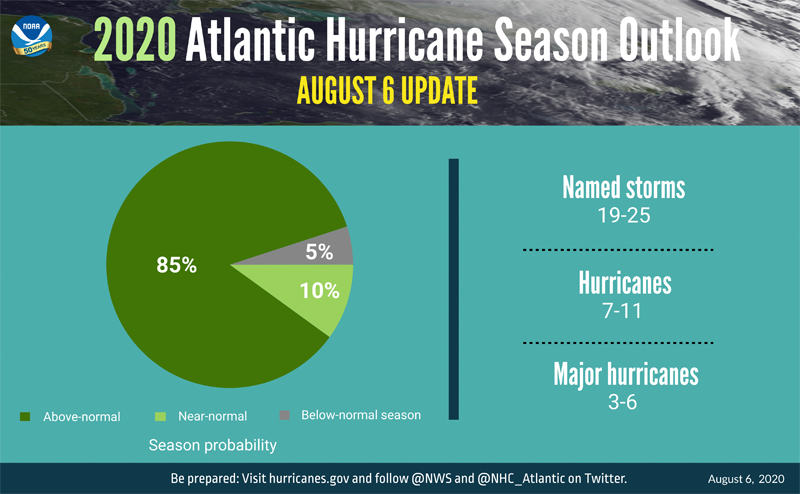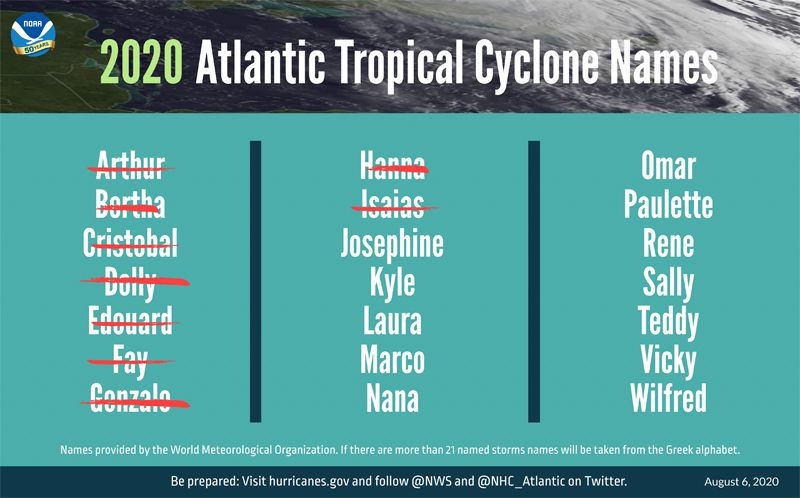NOAA: Could Be ‘Extremely Active’ Season
“Atmospheric and oceanic conditions are primed to fuel storm development in the Atlantic, leading to what could be an extremely active season,” forecasters with the U.S. NOAA Climate Prediction Center said as the agency released its annual August update to the Atlantic Hurricane Season Outlook, initially issued in May.
The organisation said, “The 2020 Atlantic hurricane season has been off to a rapid pace with a record-setting nine named storms so far and has the potential to be one of the busiest on record.
“Historically, only two named storms form on average by early August, and the ninth named storm typically does not form until October 4. An average season produces 12 named storms, including six hurricanes of which three become major hurricanes [Category 3, 4, or 5].
“The updated outlook calls for 19-25 named storms [winds of 39 mph or greater], of which 7-11 will become hurricanes [winds of 74 mph or greater], including 3-6 major hurricanes [winds of 111 mph or greater]. This update covers the entire six-month hurricane season, which ends Nov. 30, and includes the nine named storms to date.
The updated 2020 Atlantic hurricane season probability via NOAA
“A comprehensive measure of the overall hurricane season activity is the Accumulated Cyclone Energy [ACE] index, which measures the combined intensity and duration of all named storms during the season.
“Based on the ACE projection, combined with the above-average numbers of named storms and hurricanes, the likelihood of an above-normal Atlantic hurricane season has increased to 85%, with only a 10% chance of a near-normal season and a 5% chance of a below-normal season.
“This year, we expect more, stronger, and longer-lived storms than average, and our predicted ACE range extends well above NOAA’s threshold for an extremely active season,” said Gerry Bell, Ph.D., lead seasonal hurricane forecaster at NOAA’s Climate Prediction Center.
“Current oceanic and atmospheric conditions that make an ‘extremely active’ hurricane season possible are warmer-than-average sea surface temperatures in the tropical Atlantic Ocean and Caribbean Sea, reduced vertical wind shear, weaker tropical Atlantic trade winds and an enhanced west African monsoon.
“These conditions are expected to continue for the next several months. A main climate factor behind these conditions is the ongoing warm phase of the Atlantic Multi-Decadal Oscillation, which reappeared in 1995 and has been favoring more active hurricane seasons since that time.
The 2020 Atlantic tropical cyclone names via NOAA
“Another contributing climate factor this year is the possibility of La Nina developing in the months ahead. Indicative of cooler-than-average sea surface temperatures in the equatorial regions of the eastern Pacific Ocean, La Nina can further weaken the wind shear over the Atlantic Basin, allowing storms to develop and intensify.
“NOAA’s hurricane season outlook is for overall seasonal activity and is not a landfall forecast. Landfalls are largely determined by short-term weather patterns, which are only predictable within about a week of a storm potentially reaching a coastline.”



